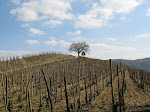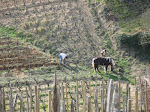I had spent 5 days on a hot bus driving through the bare Spanish country side. Every few hours, we would stop to taste at a Bodegas. A brief tasting would be followed by a three hour lunch or dinner, the latter ending sometime in the middle of the night. Spain is a really interesting country, but most of it is dry and not particularly attractive. Long days spent driving through near desert-like land started to take a toll on my psyche. Finally, on day 5 we hit Rioja. In this region, with it's green grass and full trees, I began to feel rejuvenated. After a quick stay, we jumped over to Bierzo, which proved to be gorgeous. Snow capped mountains looked down from the horizon over vine covered rolling hills. I declared to my roommate that Bierzo might be the most beautiful place I had seen with my own eyes.
The next morning the bus closed its doors and headed Northwest. Night after night of late hours finally caught up with me and my unconcsious head slid against the bus window. Several hours later, the sun became so intense that it jolted me awake. The view staring at me through the window almost threw my derriere off the seat. Vine after vine raced along the edge of the winding road and then dropped from sight. The bus weaved along the edge of a cliff. My eyes followed the vines as they shot straight down to the mighty river below. Mountains loomed on all sides. An approaching billboard spelled out the name of a village. The sign should have read 'Welcome to Ribeira Sacra, the Romans' lost vineyards.'

It is believed that Ribeira Sacra takes its name from the monasteries and hermitages that were built in the area between the 8th and 12th centuries. These religious outposts were scattered throughout the nearly inaccessible valley sides that branch off the rivers Mino and Sil. I imagine that these disciples felt close to God in this remote and stunningly beautiful area. The monks carried on the grape growing tradition in this region that had been established by the Romans centuries before and ensured that the amazing terraced vineyards were preserved until modern times. Despite this long history, the appelation was not promoted to DO status until 1997. There are actually five subzones in the DO, but almost all the vineyards share a slate bedrock foundation. This region appears to have been largely ignored throughout history, but today money is pouring into the area and new labels are appearing at a rapid pace.

The rivers twist and turn through the valley, which, I am sure, must create a complex range of terroir. Fifteen or so different grape varities are grown in the region, but the three most prominent are Mencia (red), Albarino (white) and Godello (white). One would guess that a mostly ignored region would be full of ancient vines, but it is rare to see any that are over 40 years of age. Many varieties that were thought to be inferior were ripped out and a large number of Mencia vines were planted in the 1960's and '70's. Despite being near the Atlantic, the climate is more continental. The summers and autumns are long and hot, but there is enough rainfall (800mm on average) to support the lush, green landscape.

I have only tasted a handful of wines bearing the name Ribeira Sacra, but the most interesting was made by an estate called Themera (est. 2001). The 2005, Themera, Ribeira Sacra, VV (vine age is an average of 45 years) is elegant and bright with a pronounced cherry cola flavor, which led to flashbacks of drinking cherry Coke as a kid. Therema aged this wine in a combination of Acacia and cherry oak (a tradition in the region), but I doubt that the cherry flavor in the wine came from the barrels. In contrast to this cuvee, many wines in the region are aged entirely in steel, but I find these to very simple and boring.

My trip through Ribera Sacra was spent mostly aboard a small boat. I had never before looked up at steep vineyards from the vantage point of a river. The views were breathtaking and the picture below illustrates how the vines descend down these steep hills right to the water's edge (notice that no roads are in sight). In the past, before the advent of mechanical pullies, the only access to these vineyards was by boat. Terraced plots like the ones found in Ribeira Sacra could only have been carved out of this steep terrain by slave labor (Roman era) or by religious zealots (monks). Despite our superoir technology, creating vineyards like these would be financially impossible today.

As we floated down the river, I felt as though I had just discovered the next great vineyard area. Of course, some Roman probably had the same thought. How could a region with such amazing vineyards be so unknown? The inaccessability of the area before the invention of the automobile probably contributed to its obscurity, but there have been cars in Spain for a century. Why have areas within Spain like Priorat gone from being unknown to famous and Riberia Sacra has stayed in the dark? One reason might be that this region uses little known grape varieties like Mencia, while Priorat is largely planted with the well known Grenache grape. From my limited experience, the Mencia variety can produce interesting wines, but I am not sure if these wines are capable of developing in the bottle. Most of the estates making wine in Ribeira Sacra are relatively new and do not have older vintages to show, so the answer to that question will not be known for some time.

Staring up from our boat at the vines clinging to the hillside, I could not help but wonder what might have been if the Romans had brought along with them a noble grape variety like Syrah. Would Ribeira Sacra be considered today as one of the world's great vineyard areas? Is this amazing terroir being undermined by inferior grape varieties? Perhaps Syrah, and the other noble grapes, would not have flourish in this valley. As it is, Mencia is the best local grape and deserves a shot to prove its worth. I have a feeling that the producers in the region are still trying to figure out how best to do things, both in the cellar and the vineyards, but a handful are bound to develop into stars. As a result, the region will become better known. One thing is for certain, the Romans knew a great vineyard when they saw one.
















1 comment:
Thank you for your great post on this largely undiscovered wine region. I recently discovered it through the wine shop where I work (Thirst Wine Merchants in Fort Greene). We carry several Mencia-based wines, the wines from Spain I feel good about selling. I encourage customers to do an image search of pictures from this region because it is just so incredible. People always talk about Mosel-Saar-Ruwer as having the steepest vineyards-- I think they've met their match in Ribeira Sacra!
Post a Comment